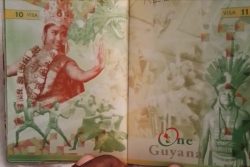Dear Editor,
Yesterday 12 October was African Holocaust Day. This is because Christopher Columbus came to these parts on 12 October 1492, and this was the beginning of the holocaust of Indigenous and African peoples in the region. In Guyana, 473, 000 Africans died to build this country and their lives go unnoticed as there are no monuments or martyrs day to acknowledge this. Of course, by not teaching history in our school system, racial entrepreneurs invent and politicize every falsehood conceivable. Even yesterday, on African Holocaust Day, we saw another falsehood being skillfully weaved into the minds of our unsuspecting youth. We seem to have lost the decency of truth in Guyana. Everything seems to be about racial superiority and historical deceptions.
Yesterday’s article entitled “21st-century agriculture” in the Guyana Times, included skillfully deceptive language about the origin of rice in Guyana. The impression given by the author was that Indians were the first to plant rice in Guyana, or as the language skillfully puts it: “on a commercial scale”. The truth is rather hidden in the same article. Rice was first introduced in 1738 by Dutch Governor, Laurens Storm van Gravesande, to supplement the diet of enslaved Africans. This is exactly 100 years before Indians came to Guyana in 1838. The truth about rice is captured in an article by Wazir Mohamed written in 2009. It can be found at (http://www.guyanajournal.com/ Wazir_Mohamed_Guyana_Rice_Industry.html). This is what Mohamed said in the section entitled “Afro-Guyanese and Rice”.
“In order to understand the reasons why Africans are not as involved as they should be in the rice industry of Guyana, it is necessary that we take a second look at the ways in which the globalization of the world sugar trade in the 19th century determined the conditions of labour.
The globalization of the sugar trade influenced the growth of the mono-crop sugar economy of Guyana in the 19th century and played a crucial role in the marginalization of the African population from land and from participation in the rice industry. Because of Guyana’s propensity for sugar and its role in the sugar revolution of the 19th century, the slave population was not only prevented from planting rice officially, but was also prohibited by force of arms to do so unofficially.”
“Unlike other areas of the West Indies, in Guyana the planter class did not permit nor sanction the development of a diversified agriculture in the colony.
They curtailed the growth of provision grounds in the colony and by the 1820s had smashed all the attempts by slaves who wanted to and who had established runaway African communities in the interior. Many of these communities had organized their living around the production of rice in the far reaches of the Abary, Mahaica and Mahaicony rivers. This is captured in the report by British Militia Captain, Charles Edmonstone, who in one of his escapades to capture runaway slaves, stumbled on a maroon community in the Abary-Mahaicony area with well-cultivated rice fields and fourteen houses filled with rice, which in his estimation could have fed 700 men for an entire year.”
This shows that while they had the knowledge, they did not have the freedom to plant rice either during slavery or after. Actions such as this of the colonial state and the planter class expressed the level of desperation that existed as the colony struggled to deal with its labour shortage. The media has an important role in a functional democracy. By deceptively spreading false truths, the editors are directly racializing and dividing Guyana.
Sincerely,
Eric Phillips
Chair, Guyana Reparations
Committee Vice Chair, CARICOM
Reparations Commission








